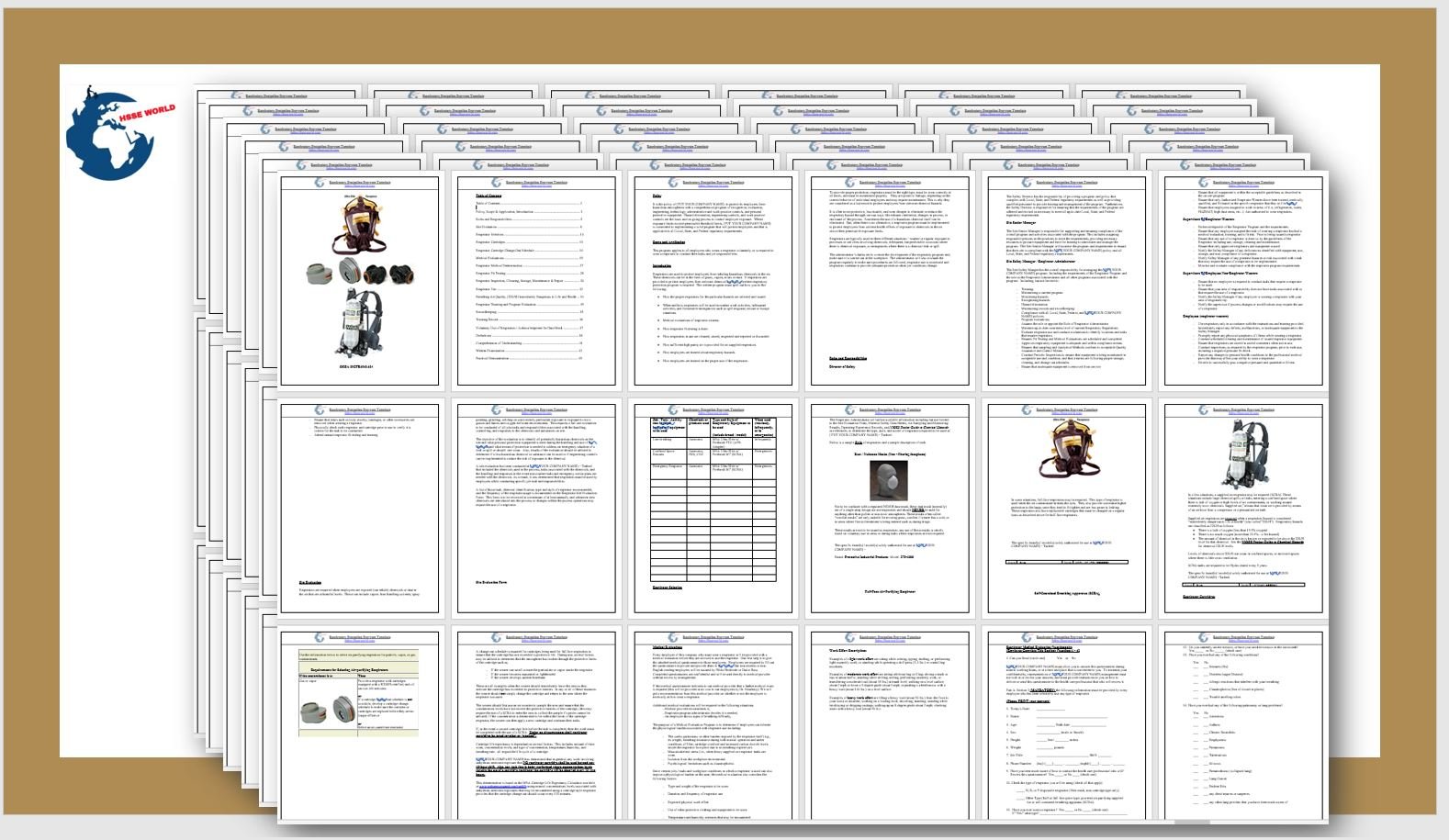It is the policy of your company. to protect its employees form hazardous atmospheres with a comprehensive program of recognition, evaluation, engineering, technology, administrative and work practice controls, and personal protective equipment. Hazard elimination, engineering controls, and work practice controls are the basis and on-going process to control employee exposure. Where exposure limits exceed permissible threshold limits, your company is committed to implementing a solid program that will protect employees and that is applicable to all Local, State, and Federal regulatory requirements.

Scope and Application
This program applies to all employees who wears a respirator voluntarily or is required to wear a respirator to conduct their tasks and job responsibilities
Respirators are used to protect employees from inhaling hazardous chemicals in the air. These chemicals can be in the form of gases, vapors, mists or dust. If respirators are provided to protect employees from airborne chemical hazards, a written respiratory protection program is required. The written program must spell out how you do the following:
- How the proper respirators for the particular hazards are selected and issued.
- When and how respirators will be used in routine work activities, infrequent activities, and foreseeable emergencies such as spill response, rescue or escape situations.
- Medical evaluations of respirator wearers.
- How respirator fit-testing is done.
- How respirators in use are cleaned, stored, inspected and repaired or discarded.
- How sufficient high purity air is provided for air-supplied respirators.
- How employees are trained about respiratory hazards.
- How employees are trained on the proper use of the respirators.
To provide proper protection, respirators must be the right type, must be worn correctly at all times, and must be maintained properly. They are prone to leakage, depending on the correct behavior of individual employees and may require maintenance. This is why they are considered as a last resort to protect employees from airborne chemical hazards.
It is often more protective, less trouble, and even cheaper to eliminate or reduce the respiratory hazard through various ways like exhaust ventilation, changes in process, or enclosure of the process. Sometimes the use of a hazardous chemical itself can be eliminated. But, when there is no alternative, a respirator program must be implemented to protect employees from adverse health effects of exposure to chemicals in the air above their permissible exposure limits.
Respirators are typically used in three different situations – routine or regular exposure to processes or activities involving chemicals, infrequent, but predictable occasions where there is chemical exposure, or emergencies where there is a chemical leak or spill.
The administrator’s duties are to oversee the development of the respiratory program and, make sure it is carried out at the workplace. The administrator will also evaluate the program regularly to make sure procedures are followed, respirator use is monitored and respirators continue to provide adequate protection when job conditions change.
Table of Contents
Table of Contents ———————————————————————- 2
Policy, Scope & Application, Introduction —————————————– 3
Roles and Responsibilities ———————————————————— 5
Site Evaluation ————————————————————————- 8
Respirator Selection ——————————————————————- 10
Respirator Cartridges —————————————————————– 13
Respirator Cartridge Change-Out Schedule ————————————— 14
Medical Evaluations —————————————————————— 15
Respirator Medical Determination ————————————————– 27
Respirator Fit Testing —————————————————————– 28
Respirator Inspection, Cleaning, Storage, Maintenance & Repair ————– 30
Respirator Use ————————————————————————- 32
Breathing Air Quality, (IDLH) Immediately Dangerous to Life and Health — 34
Respirator Training and Program Evaluation ————————————– 35
Recordkeeping ————————————————————————- 35
Training Record ———————————————————————– 36
Voluntary Use of Respirators / Acknowledgment for Dust Mask ————– 37
Definitions —————————————————————————– 38
Comprehension of Understanding ————————————————– 41
Written Examination —————————————————————– 42
Practical Demonstration ————————————————————- 45
The following template can be used to help your organization develop a written Respiratory Protection Program. This template cannot be used as is – you must customize the template to meet the needs of your organization. We have made this template easier for you to customize by adding visual prompts that identify some areas where your input is needed. These are identified by Red highlighted, red text in the template. You may also change any of the text in the template to meet your organization’s needs – for example, Company department names, job titles, listed responsibilities and audiologist.
Disclaimer. This sample written Respiratory Protection Program template cannot be used as is. You must customize the template to meet the needs of your organization. HSSE WORLD does not guarantee that this template is or can be relied on for compliance with any law or regulation, assurance against preventable losses, or freedom from legal liability. We make no representations or warranties of any kind whatsoever, either express or implied, in connection with the use of this template. HSSE WORLD will not be liable for your use of the template as customized by you. All safety programs and policies, including this template and the information you supply to complete it, should be reviewed by your legal counsel and/or risk management staff.



